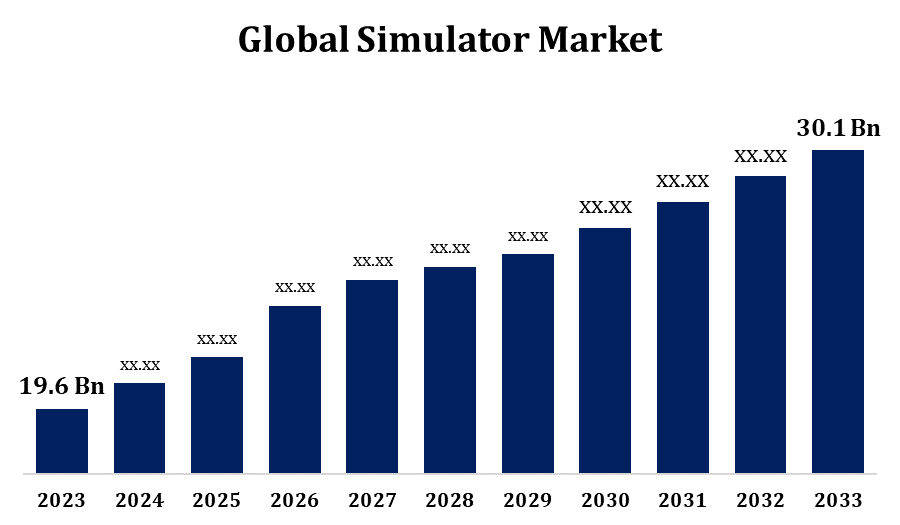Global Simulator Market Size To Worth USD 30.1 Billion By 2033 | CAGR of 4.38%
Category: Aerospace & DefenseGlobal Simulator Market Size To Worth USD 30.1 Billion By 2033
According to a research report published by Spherical Insights & Consulting, the Global Simulator Market Size to Grow from USD 19.6 Billion in 2023 to USD 30.1 Billion by 2033, at a Compound Annual Growth Rate (CAGR) of 4.38% during the forecast period.

Get more details on this report -
Browse key industry insights spread across 200 pages with 110 Market data tables and figures & charts from the report on the "Global Simulator Market Size By Application (Training, Research & Development, Others), By Type (Full Flight Simulation, Fixed Base Simulation, Driving Simulation, Others), By End Use Industry (Aerospace & Defense, Automotive, Marine & Naval, Media & Entertainment), By Region, And Segment Forecasts, By Geographic Scope And Forecast to 2033." Get Detailed Report Description Here: https://www.sphericalinsights.com/reports/simulator-market
Simulators are utilised in a variety of areas, including education, research, and entertainment. This market encompasses a wide range of applications, including flight simulation, driving simulation, military training simulators, virtual reality (VR), and augmented reality (AR), among others. As technology improves, the simulator industry grows and diversifies, with innovations such as VR and AR unlocking new possibilities for immersive simulation experiences. Furthermore, the increasing usage of simulation technology in fields such as healthcare, education, and gaming is widening the industry's scope. Furthermore, the industry is gaining traction as need for training, skill development, and risk management grows across numerous industries. Simulation emerges as a cost-effective and efficient alternative to traditional teaching methods, providing opportunities for research, testing, and analysis.
Simulator Market Value Chain Analysis
The simulator market's value chain is comprised of a number of interconnected stages, beginning with research and development of advanced simulation technologies. Manufacturers build hardware components, while software developers generate specific simulation applications that integrators integrate into customised systems. Distributors oversee product distribution, whilst sales teams work with customers to understand their needs. Training providers educate users on system operation, whilst technical support teams give assistance. End customers from several industries use simulation for teaching, research, and enjoyment. Maintenance contracts maintain system reliability, while feedback informs future innovation initiatives, so closing the value chain loop and increasing market competitiveness.
Simulator Market Opportunity Analysis
The simulator market offers tremendous opportunities, driven by rising demand for training, skill development, and risk mitigation across a wide range of sectors. With simulation providing cost-effective and efficient alternatives to traditional training techniques, there is plenty of room for innovation and growth. Furthermore, simulation technology allows for research, experimentation, and analysis, which enhances its value offer. As industry recognise the benefits of simulation, such as increased safety, lower costs, and higher training efficacy, the market is positioned for long-term growth. Emerging technologies such as virtual reality (VR) and augmented reality (AR) are also driving market growth, opening up new options for immersive simulation experiences. Overall, the simulator market presents opportunities for businesses to capitalise on changing industry needs and technology improvements.
The demand for simulator training in the military, aviation, and naval sectors has been steadily increasing. Simulators offer a safe, cost-effective, and efficient way to train troops in a range of scenarios, such as aircraft movements and combat simulations. As technology progresses, these simulations become increasingly sophisticated, offering incredibly realistic landscapes and settings that closely mirror actual events. As military operations and aircraft missions become more complex, the importance of successful simulation training increases. This trend is likely to drive significant growth in the simulator sector, as armed forces and aviation corporations prioritise readiness and proficiency through improved training solutions.
Simulators can be expensive to develop, maintain, and operate. High initial investment costs may be prohibitive for some businesses, notably smaller ones or those operating in developing countries. Achieving high levels of realism and accuracy is crucial for simulator effectiveness. Simulators must provide realistic feedback and responses to user interaction, requiring extensive modelling and simulation techniques. In educational settings, incorporating simulators into existing curricula may be tricky. Educators must ensure that simulator-based training is relevant to learning objectives and complements other instructional methods. The simulator market is very competitive, with many manufacturers offering a wide range of products and solutions. Standing out in a crowded market requires continuous innovation, quality assurance, and effective marketing strategies.
Insights by Type
The full flight simulation segment accounted for the largest market share over the forecast period 2023 to 2033. As global air travel expands, so does the demand for well-trained pilots. Full Flight Simulators offer a realistic training environment in which pilots can practise numerous scenarios and procedures without the use of actual aircraft. As more airlines grow their fleets and itineraries, the demand for pilot training, including FFS usage, is projected to increase. The expansion of low-cost airlines (LCCs) in many countries has boosted demand for pilot training services. LCCs frequently seek cost-effective training options, and Full Flight Simulators provide great training quality without the requirement for costly aircraft operations. This trend has helped to drive the expansion of the FFS industry.
Insights by Application
The training segment is dominating the market with the largest market share over the forecast period 2023 to 2033. Across businesses, there is a growing demand for competent individuals who possess the necessary knowledge and competencies to complete their responsibilities effectively. Simulator-based training creates a safe and controlled environment for hands-on learning, allowing students to develop and practise important skills without risking their safety or expensive equipment. As organisations become global and markets expand into new nations, there is a growing desire for standardised training programmes that can be delivered consistently across several locations. Simulators offer a scalable and customisable training system that may be used globally, resulting in consistent training outcomes. Simulator-based training can be more cost-effective than traditional methods, particularly in industries where real-world training is prohibitively expensive or dangerous.
Insights by End Use
The aerospace and defence segment accounted for the largest market share over the forecast period 2023 to 2033. Commercial air travel is expanding globally, creating demand for well-trained pilots. Simulators, particularly Full Flight Simulators (FFS) and Flight Training Devices (FTD), are essential in pilot training because they provide realistic and immersive teaching environments without the use of actual aircraft. Defence forces throughout the world are investing in advanced simulation technologies to boost training effectiveness and readiness. Military simulators are used to train pilots, ground crew, and mission planners in a wide range of scenarios, including aerial warfare, mission rehearsal, and emergency response. The increasing complexity of modern military operations necessitates high-fidelity simulation systems.
Insights by Region

Get more details on this report -
North America is anticipated to dominate the Simulator Market from 2023 to 2033. North America is home to a significant portion of the global aviation industry, including major aircraft manufacturers, airlines, and training centres. Aviation simulators, including flight simulators and maintenance training devices, are commonly used for pilot training, aircraft maintenance, and emergency drills. Medical simulation is gaining popularity in North America, where simulators are used for medical education, training, and patient care. Healthcare simulation offers a wide range of uses, including surgical simulation, patient simulation, medical procedure teaching, and virtual reality-based therapy. North America's wide network of roads and highways creates a large market for driving simulators. These simulators are used for driver training, evaluation, and research on autonomous vehicle technologies.
Asia Pacific is witnessing the fastest market growth between 2023 to 2033. With Asia-Pacific as one of the world's fastest-growing aviation economies, there is a greater demand for aviation simulators for pilot training, aircraft maintenance, and air traffic control training. Major airlines, aircraft manufacturers, and training institutions in China, India, Singapore, and Australia are investing in cutting-edge simulation technologies. Several Asia-Pacific countries are expanding their defence capabilities, resulting in increased demand for military simulation systems. These simulators are used to teach military personnel a wide range of abilities, including flying training, battle scenarios, weapon system operating, and mission planning. The healthcare industry in Asia-Pacific is quickly developing its simulation-based training programmes for medical personnel. Medical simulation is used in surgical training, patient care simulations, and medical education.
Recent Market Developments
- In July 2023, Iran successfully showcased the MiG-29 simulator to improve the fighting capabilities of its armed forces. Shahid Sattari Aeronautical University conducted electronic warfare simulations using Su-24 and F-4 fighter jets.
Major players in the market
- CAE Inc. (US)
- L3Harris Technologies Inc. (US)
- Thales Group (France)
- Saab AB (Sweden)
- Indra (Spain)
- Flight Safety International (US)
- Boeing (US)
- Raytheon Technologies Corporation (US)
- Airbus S.A.S. (Netherlands)
Market Segmentation
This study forecasts revenue at global, regional, and country levels from 2023 to 2033.
Simulator Market, Type Analysis
- Full Flight Simulation
- Fixed Base Simulation
- Driving Simulation
- Others
Simulator Market, Application Analysis
- Training
- Research & Development
- Others
Simulator Market, End Use Analysis
- Aerospace & Defense
- Automotive
- Marine & Naval
- Media & Entertainment
Simulator Market, Regional Analysis
- North America
- US
- Canada
- Mexico
- Europe
- Germany
- Uk
- France
- Italy
- Spain
- Russia
- Rest of Europe
- Asia Pacific
- China
- Japan
- India
- South Korea
- Australia
- Rest of Asia Pacific
- South America
- Brazil
- Argentina
- Rest of South America
- Middle East & Africa
- UAE
- Saudi Arabia
- Qatar
- South Africa
- Rest of Middle East & Africa
About the Spherical Insights & Consulting
Spherical Insights & Consulting is a market research and consulting firm which provides actionable market research study, quantitative forecasting and trends analysis provides forward-looking insight especially designed for decision makers and aids ROI.
Which is catering to different industry such as financial sectors, industrial sectors, government organizations, universities, non-profits and corporations. The company's mission is to work with businesses to achieve business objectives and maintain strategic improvements.
CONTACT US:
For More Information on Your Target Market, Please Contact Us Below:
Phone: +1 303 800 4326 (the U.S.)
Phone: +91 90289 24100 (APAC)
Email: inquiry@sphericalinsights.com, sales@sphericalinsights.com
Contact Us: https://www.sphericalinsights.com/contact-us
Need help to buy this report?